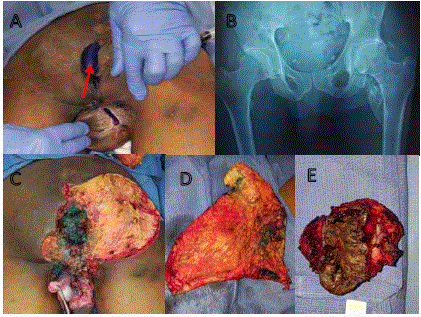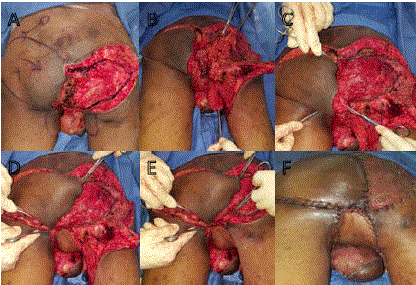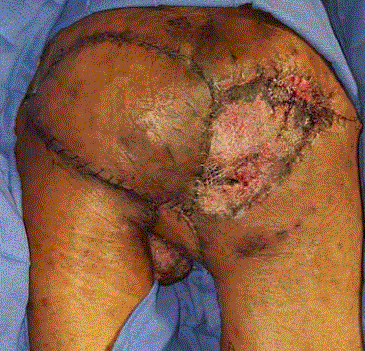Case Report
Staged Ablation and Complex Reconstruction of Extensive Perineal Hidradenitis Suppurativa
Michael R DeLong1 and Salah Rubayi2*
1Department of Surgery, University of California at Los Angeles, California, USA
2Department of Surgery, Rancho Los Amigos National Rehabilitation Center, California, USA
*Corresponding author: Salah Rubayi, Department of Surgery, Rancho Los Amigos National Rehabilitation Center, 7601 Imperial Hwy, Downey, California 90242, USA
Published: 18 Jul, 2018
Cite this article as: DeLong MR, Rubayi S. Staged
Ablation and Complex Reconstruction
of Extensive Perineal Hidradenitis
Suppurativa. Clin Surg. 2018; 3: 2040.
Abstract
Hidradenitis Suppurative (HS) is a potentially debilitating chronic inflammatory condition affecting apocrine gland-bearing tissue found in the axilla and perineum. We describe the staged ablation and complex reconstruction of extensive HS involving the perineum, gluteus, scrotum, and perianal region in a paraplegic patient. Complete eradication of the disease required diverting colostomy, anal closure, and extensive subcutaneous tissue excision. At a second stage, reconstruction was performed with bilateral gluteal advancement flaps to cover the rectal stump, a rotation medial thigh fasciocutaneous flap to provide durable coverage for the perineum, and split thickness skin grafting to reconstruct the scrotum and denuded gluteal muscle. With this technique, the patient was successfully cured of his HS and was provided an excellent reconstruction.
Introduction
Hidradenitis suppurativa (HS) is a chronic inflammatory condition affecting the apocrine
sweat gland-bearing tissues present primarily in the axilla and perineum [1]. The etiology of HS is
incompletely understood but is believed to possibly involve a combination of follicular occlusion,
glandular dysfunction, hormonal imbalance, autoimmune response, and possible bacterial superinfection
[2]. No definite causative factors have been identified, but obesity, humidity, and certain
medications have been associated with an increased risk [3]. HS can range in severity from isolated
pustules to extensive sinus tracts with copious malodorous purulence, which is socially debilitating
for affected patients. Malignant degeneration has also been described in rare cases [4].
First line medical management for less severe HS usually employs lifestyle changes, weight
loss, and antimicrobials and anti-inflammatory medications, such as Doxycycline [3]. Second line
treatment with more potent immunomodulators such as Infliximab has been described with relative
success [5]. However, for severe HS or medically refractory patients, surgery is reserved as a final
treatment modality. Surgical management of HS requires the complete excision of all involved
glands and tissues which generally results in a large denuded area. Subsequent reconstruction is
often staged until complete eradication of the disease is confirmed to prevent coverage of an infected
wound. We describe the staged ablation and complex reconstruction of extensive and severe HS in
a paraplegic patient.
Case Presentation
The patient is a thirty-five year old African American male with a history of thoracic level 4 (T4)
complete paraplegic spinal cord injury secondary to a gunshot wound suffered in 2003. During his
initial trauma he underwent thoracotomy, partial right lobe resection, and exploratory laparotomy.
After recovering from the acute injury, he suffered from chronic neurogenic bowel and bladder,
muscle spasms, and developed severe chronic hidradenitis suppurativa affecting his scrotum,
perineum, perianal area, and gluteal soft tissues for at least four years. In 2013 he underwent staged
bilateral inguinal HS excision bridged with wound vacuum to split thickness skin grafting at an
outside hospital. He then underwent further debridement of his scrotum and perinuem in 2014 at
a different hospital. The other hospital's colorectal surgery service evaluated him at that time and
recommended no management of his peri-anal HS.
He presented to the clinic at Rancho Los Amigos Medical Center in March 2018 with extensive
disease and significant purulent drainage from his peri-anal region, gluteal soft tissue, perineum, and
posterior scrotum. He was temporized with Levaquin and Flagyl to attenuate the purulent discharge
and was electively admitted the following month for surgical management. Diverting end sigmoid
colostomy and mucous fistula was performed by general surgery
in anticipation of his excision and reconstruction. He recovered
uneventfully from his ostomy and was taken on postoperative day 8
for excision of his affected tissues (Figure 1). During this surgery, his
anus was excised and rectal stump was closed with absorbable sutures.
Methylene blue dye was infiltrated through all external sinuses and
involved tissue was aggressively debrided including his scrotum,
right gluteal subcutaneous fat and skin, and perineum. At the end
of this surgery he was continued on Vancomycin and Meropenem
and his wound was packed with Dakin's wet-to-dry dressings daily
and his condition was followed on the wards. After one week it was
confirmed that his remaining tissues were clear of disease, and he was
taken on postoperative day 11(debridement)/19 (ostomy) for final
reconstruction (Figure 2).
The initial objective of reconstructive surgery was durable
tissue coverage of the rectal stump and perineal region given the
patient's paralysis and anticipated wheelchair sitting. Bilateral gluteal
advancement V-Y flaps were mobilized and stacked over the rectal
stump to provide a robust layer of soft tissue coverage. The perineum
was then surfaced with a rotation fasciocutaneous flap from the
right medial thigh, and the donor site was closed primarily. After the
susceptible regions were covered with durable tissue, the right gluteal
muscle and scrotum still required skin coverage. Because the gluteus
already had a thick layer of muscular coverage and the scrotum was
not a site of future compression, these areas were grafted with a split
thickness skin graft taken from the right lower leg.
The dressings were removed eight days after reconstructive
surgery and the reconstruction was found to be intact with viable
flaps. Our ablative surgery successfully removed all of the patient's
HS and the ultimate reconstruction provided appropriate coverage
of all of the critical structures with a maintained resistance to future
breakdown with prolonged wheelchair sitting (Figure 3).
Figure 1
Figure 1
Hidradenitis debridement. (A) Extensive disease involving
scrotum and anus. Methylene blue dye escaping from sinus tracts surrounding
anus when injected through sinus tract opening in right gluteus(red arrow). (B)
Preoperative radiograph demonstrating no extensive heterotopic ossification
or osteomyelitis. (C) After excision of anus and closure of rectal stump and
debridement of scrotum, perineum, and right gluteal soft tissues. Residual
methylene blue staining observed over rectal stump. Exposed testicle being
held in forceps. (D) Excised specimen - right gluteal subcutaneous tissue and
skin. (E) Excised specimen - anus.
Figure 2
Figure 2
Reconstruction of defect. (A) Preoperative defect with planned
surgery depicted. Left gluteal advancement flap. Right gluteal muscle
advancement. Right medial thigh fasciocutaneous flap. (B) After flap
dissection all of the flaps can be seen mobilized. (C) Closure of the rectal
stump with bilateral advancement of the gluteal flaps. (D) Rotation of the right
medial thigh flap to cover the perineum. (E) Advancement of right posterior
thigh skin. (F) On-table postoperative result with meshed flaps inset and skin
graft to right gluteus and scrotum.
Figure 3
Figure 3
Postoperative day eleven result. Flaps and skin graft viable and
intact. Rectal stump successfully covered and perineum protected by robust
medial thigh rotation flap.
Conclusion
The staged extirpation and complex reconstruction of extensive severe HS in a paraplegic patient is possible and safe but requires the selection of multiple synergistic flaps to provide a successful result.
References
- Revuz J. Hidradenitis suppurativa. J Eur Acad Dermatology Venereol. 2009;23(9):985-98.
- Alikhan A, Lynch PJ, Eisen DB. Hidradenitis suppurativa: A comprehensive review. J Am Acad Dermatol. 2009;60(4):539-61.
- Slade DEM, Powell BW, Mortimer PS. Hidradenitis suppurativa: Pathogenesis and management. Br J Plast Surg. 2003;56(5):451-61.
- Grewal NS, Wan DC, Roostaeian J, Rubayi SR. Marjolin ulcer in hidradenitis suppurativa: Case reports. Ann Plast Surg. 2010;64(3):315-7.
- Delage M, Samimi M, Atlan M, Machet L, Lorette G, Maruani A. Efficacy of infliximab for hidradenitis suppurativa: Assessment of clinical and biological inflammatory markers. Acta Derm Venereol. 2011 Mar;91(2):169-71.



